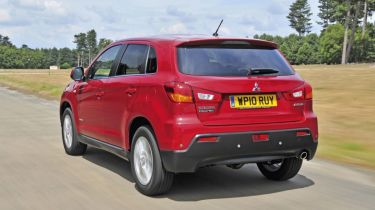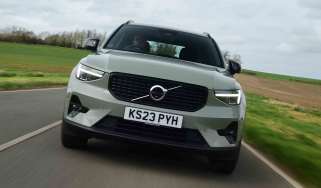Mitsubishi ASX 3 1.8
The new Mitsubishi certainly has its work cut out to beat its more established rivals, but good looks and clever tech give it a fighting chance.
For many buyers, Mitsubishi means only one thing: the Evo X. The scorching rally-bred saloon dominates headlines, but sells in relatively small numbers. Bosses hope the ASX will attract a wider audience to the brand – and, crucially, bring more customers into showrooms.
The newcomer hasn’t forgotten its roots, because the chunky SUV clearly shares its DNA with the four-door. The nose has the same aggressive grille, while the bold, swept-back headlights are familiar, too.
Video: watch CarBuyer's video review of the Mitsubishi ASX
[[{"type":"media","view_mode":"content_narrow","fid":"68557","attributes":{"alt":"","class":"media-image"}}]]
The rest of the ASX isn’t quite as interesting – the body looks dull next to the distinctive Yeti and sleek Qashqai, with little to break up the slab-sided panels. It’s neatly designed and well proportioned, and the raised ride height and black cladding on the bumpers give the car a rugged, off-roader appearance. But ultimately, it fails to turn heads.
A similarly low-key approach has been applied to the interior. In general, quality is a marked improvement on previous efforts from Mitsubishi – soft-touch materials have been added to the upper part of the dashboard and the doors.
Yet there are some hard and shiny plastics, and the switchgear could do with an update. In particular, the bank of switches to the right of the wheel is not only hard to find – especially after dark – but feels cheap. There’s no space for an integrated sat-nav, either, so the only option for buyers is an aftermarket dealer-fit device.
The rest of the dashboard is well laid out, while standard equipment is plentiful – our mid-spec ASX 3 gets cruise and climate control, as well as Bluetooth. The seats are comfortable, too, although the dark fabric is a little sombre.
Passengers in the rear are treated to an abundance of room, and the high-set front seats allow lots of space for feet to be slid underneath. With the rear bench in place, there’s a useful 442-litre luggage capacity – that’s 26 litres more than in the Yeti. And while the back seats can’t be taken out completely, the ASX benefits from a split-fold rear seat and useful ski hatch. We just wish Mitsubishi included straps or netting to secure smaller items.
The 1.8-litre diesel is fired up via the starter button next to the steering wheel – although the pre-heat process for the glow plugs seems to take longer than on its rivals. When idling, the powerplant is the quietest here, whether you’re sitting in the car or standing next to it. At a standstill, the idle speed drops to a very low 600rpm – which helps to boost fuel economy.
That last part is significant, as the ASX is the first car in the world to use a diesel engine equipped with variable valve timing. It’s part of a series of tweaks aimed at making the car environmentally friendly. Mitsubishi has also fitted its first-ever stop-start system – called Auto Stop & Go – as well as regenerative braking, while low-viscosity oil and low-rolling-resistance tyres feature, too.
Unfortunately we were unable to record full fuel economy figures, but Mitsubishi claims the newcomer will return 51.4mpg – only 0.9mpg less than the Yeti. It also promises to be nearly as clean as the Skoda. The ASX emits 145g/km of CO2, so road tax is £125 a year – £15 more
than for the Czech machine.
Our only criticism is that the stop-start could fire the engine more quickly when the traffic lights turn green. Once you’re up and running, and on more challenging roads, the soft suspension means the Mitsubishi doesn’t handle as well as the nimble Skoda, with body roll proving an issue in tighter bends. But apart from the lean and some occasional wallow over bumps, the ride is comfortable enough.
The six-speed manual is notchy, which discourages you from making the most of the engine’s power band, and while the steering wheel feels and looks great, it doesn’t offer as much feedback as the Yeti or Qashqai through corners. Most disappointing of all was the model’s braking performance. It took 54.3 metres to come to a halt from 70mph at the test track – over 4.5 metres more than either opponent.
Nevertheless, the ASX has a broader appeal than any Mitsubishi before it, with plenty of space, a great engine and a step up in interior quality. It’s also impressively green and well equipped, and is a credible rival for the class’s establishment.
Details
Chart position: 3
WHY: Mitsubishi is playing catch-up in the crossover market, but the new ASX promises to build on the brand’s SUV know-how. Add efficient engines and eye-catching looks inspired by the Evo, and it promises to be a contender.



